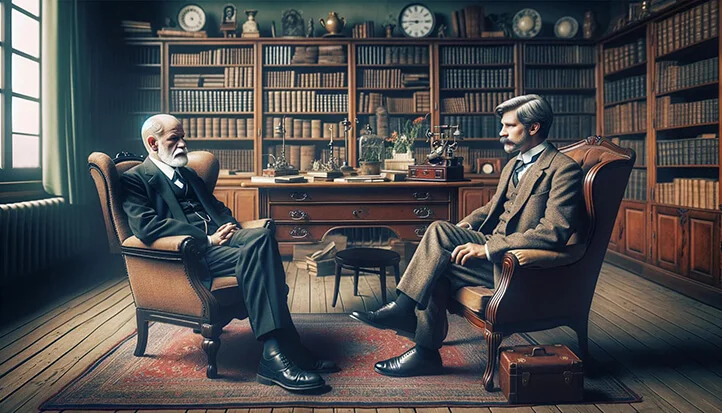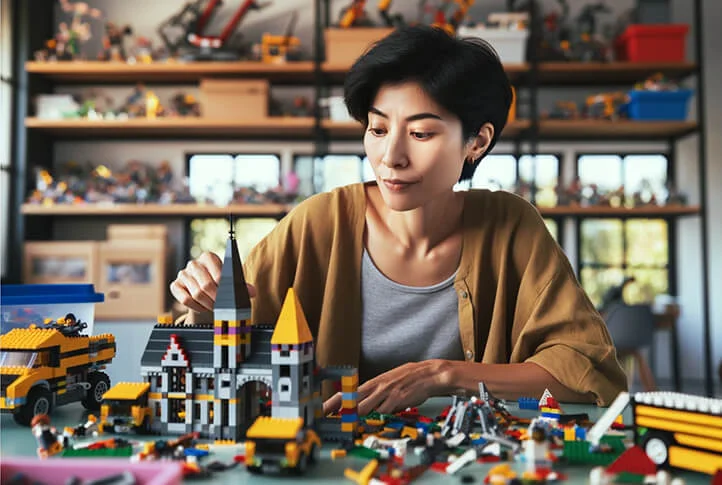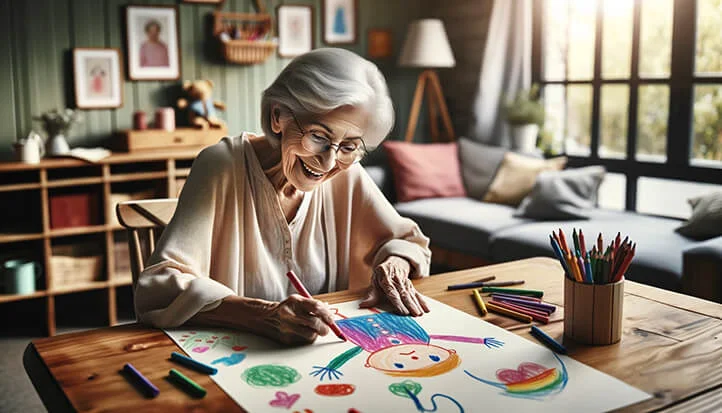The concept of the “inner child” in psychology refers to the part of an adult’s psyche that retains the perceptions, feelings, and experiences lived through in childhood. This idea is based on the notion that adults are not entirely separated from their childhood emotions and memories. The inner child can manifest in various forms, including instinctive reactions, playfulness, intuition, spontaneity, as well as challenges with emotional regulation and unresolved childhood traumas.
Working with the inner child is often employed in psychotherapy as a means to help individuals heal from past psychological wounds, resolve internal conflicts, and enhance emotional well-being. This involves processes of recognizing, acknowledging, and integrating childhood experiences into the adult self, which can promote greater emotional maturity and well-being.
The significance of the inner child for an adult’s emotional well-being cannot be overstated. This aspect of the psyche, storing memories, feelings, and impressions from childhood, exerts a profound influence on behavior, emotional reactions, and worldviews in adulthood. Understanding and accepting one’s inner child allows for a deeper awareness of the reasons behind emotional responses, which is key to resolving internal conflicts and past traumas.
Active work with the inner child in the context of self-exploration or psychotherapy helps adults better understand themselves and their needs. This leads to improved self-esteem and the development of healthier relationships.
On the other hand, ignoring or suppressing the inner child may result in emotional blocks, chronic stress, and difficulties in interacting with others. Thus, nurturing and caring for the inner child not only fosters emotional healing but is also a crucial factor in achieving deep personal growth and emotional well-being.

The History of the Concept of the “Inner Child”
The history of the concept of the “inner child” in psychology began with Sigmund Freud, the founder of psychoanalysis, who focused on the importance of childhood experiences and their influence on the development of the adult psyche, especially through the Oedipus complex.
After Freud, Carl Jung, a Swiss psychiatrist and the founder of analytical psychology, expanded the exploration of the inner world by introducing the concept of archetypes, including the “eternal child” archetype, which embodies inner childlike qualities in adulthood.
The further development of the concept came through the works of Eric Berne, the creator of transactional analysis. Berne introduced the “Parent-Adult-Child” model, where the “child” is presented as a system of feelings and reactions formed in childhood. These ideas were further developed in various psychotherapeutic approaches, including Gestalt therapy and cognitive-behavioral therapy.
In the 1980s and 1990s, the concept of the inner child gained widespread popularity thanks to the work of John Bradshaw, who actively popularized the idea of working with the inner child to heal psychological wounds.
Today, the concept of the inner child is a crucial element in psychotherapy. It helps better understand the emotional reactions of adults, rooted in their childhood experiences and memories, and is used to improve self-awareness and personal growth.
Psychological Theories Related to the Concept of the Inner Child
The concept of the inner child is associated with several key psychological theories, which together form the foundation for understanding this idea:
- Sigmund Freud’s Psychoanalysis: Freud was one of the first to emphasize the importance of childhood experiences for the adult psyche. His theories on sexual development, the Oedipus complex, and the stages of psychosexual development highlight the influence of early years on personality formation.
- Carl Jung’s Analytical Psychology: Jung developed the concept of archetypes, including the “eternal child” or “puer aeternus” archetype. According to him, this archetype represents an element of the unconscious that retains childlike aspects of personality and plays a key role in individualization and human development.
- Eric Berne’s Transactional Analysis: In this model, adult behavior is analyzed through three ego-states: Parent, Adult, and Child. The “Child” represents the state in which emotions and behaviors from childhood manifest, including both adaptive and maladaptive aspects.
- Fritz Perls’ Gestalt Therapy: The Gestalt approach emphasizes the wholeness of experience and the importance of unconscious feelings and experiences. Working with the inner child in this context involves exploring unresolved emotions and issues from childhood.
- Positive Psychology: In positive psychology, the focus is on developing a person’s strengths and potential. The inner child is seen as a source of creativity, joy, and spontaneity.
- Cognitive-Behavioral Therapy (CBT): While CBT traditionally focuses on changing negative thought patterns and behaviors, it can also involve working with the inner child, particularly in the context of healing psychological wounds and reinterpreting childhood experiences.
- Play Therapy, Art Therapy, and Music Therapy: These approaches are especially relevant for working with the inner child, as they allow adults to express and explore their childhood feelings and experiences through play, art, music, and other creative forms.
These various theoretical approaches and therapeutic practices enrich the understanding of the importance of the inner child in psychological work and self-development. They allow for a deeper exploration of how early childhood experiences shape adult personality, behavior, and emotional responses. Working with the inner child helps resolve long-standing emotional problems associated with past traumas and promotes the development of healthier stress-coping strategies and emotional intelligence.
This diversity of approaches also highlights the uniqueness of each individual and their personal experiences, offering psychologists and clients a variety of tools and methods for therapeutic work. From Gestalt therapy and transactional analysis to positive psychology and cognitive-behavioral approaches, each theory contributes to understanding how the inner child influences our lives and how to better integrate it into modern adult existence.
The Impact of Past Psychological Traumas on the Inner Child
Past traumas, especially those experienced in childhood, can become deeply rooted in the psyche and have a long-lasting impact on an adult’s emotional state, behavior, and relationships.
- Emotional Impact: Unresolved childhood traumas can cause the inner child to remain stuck in states of fear, anger, sadness, or helplessness. This may manifest as heightened anxiety and depression, emotional instability, or suppression in adulthood.
- Behavioral Manifestations: Adults whose unresolved childhood traumas affect their inner child often engage in destructive or self-destructive behaviors. This includes difficulties in setting boundaries, issues with addictions, avoidance of close relationships, or repeating relationships characterized by abuse or neglect.
- Impact on Relationships: Childhood traumas can severely affect an adult’s ability to build and maintain healthy relationships. The influence of these traumas on the inner child may lead adults to seek the sense of safety and validation in relationships that they sought in childhood. This can result in repeating familiar but unhealthy behavioral patterns that were characteristic of their early relationships. These patterns often include attachment to partners displaying unhealthy behaviors, as an attempt to recreate and “fix” unresolved childhood issues.
- Self-Perception: Traumas can affect an adult’s self-esteem and self-perception, causing feelings of unworthiness or inadequacy that originated in childhood.
- Physiological Reactions: Physical responses to stress and trauma can also be linked to the inner child. Stress reactions such as hyperarousal or numbness may be the result of defense mechanisms developed in childhood.
Working with the inner child in therapy is aimed at healing these traumas, allowing the adult to rethink and process childhood experiences, restore emotional balance, and build healthier relationships and life patterns. This involves acknowledging and expressing repressed emotions, developing new ways to manage stress, and forming a healthier self-perception.

The Difference Between the Inner Child and Adult “Self”
Understanding the difference between the inner child and the adult “self” is a key aspect of psychological self-awareness and personal growth. The adult “self” and inner child coexist within us, influencing our decisions, emotions, and behavior, though their expressions and functions differ significantly.
The inner child represents our capacity for feelings, intuition, and creativity, but it can also be the source of old fears and traumas. On the other hand, the adult “self” reflects our ability to rationally analyze, make responsible decisions, and manage our behavior according to the realities of adult life.
This coexistence of two such distinct sides of the personality often creates internal conflicts and contradictions. Our inner child may seek freedom and playfulness, while the adult “self” focuses on responsibilities, norms, and realistic expectations.
Of course, each of these aspects plays a unique and important role in our lives. Conscious interaction between the inner child and adult “self” paves the way to a more harmonious existence, where emotions and rationality find common ground, and the past and present combine seamlessly to provide complete emotional well-being.
Description of Inner Child Characteristics
The inner child is a metaphor that describes the part of an adult’s personality directly connected to emotions and childhood memories. The characteristics of the inner child may vary depending on the individual’s unique traits and life experiences, but there are several common features:
- Emotional sensitivity. The inner child often manifests through deep and intense emotions such as joy, anger, sadness, or fear. These emotions can be raw and unprocessed, like those of a child.
- Creativity and playfulness. The inner child is also responsible for creative abilities and playfulness, art, fantasies, and spontaneity, often linked to a child’s perception of the world.
- Intuition. This part of the personality can express itself through an intuitive understanding or “sixth sense,” which is not always logical or justified.
- Long-standing psychological trauma. For many people, the inner child holds unresolved traumas, fears, and grievances from childhood, which can influence behavior and emotional states in adulthood.
- The search for safety and acceptance. The inner child seeks a sense of security, love, and acceptance, and this desire can affect interpersonal relationships in adulthood.
- Resistance to change and control. Like children, the inner child may display stubbornness and resistance to changes or control, especially if these changes seem to threaten its psychological safety.
- Needs and desires. The inner child also reflects unconscious or suppressed needs and desires that were important in childhood but might have been ignored or unmet.
Comparison of the Inner Child with the Adult Personality
Comparing the inner child with the adult personality allows for a better understanding of the dynamics of personal development and the interaction of different parts of the psyche. Here are the key aspects of this comparison:
Emotional reactions
-
- The inner child expresses itself through direct and often intense emotions. These reactions can be spontaneous and strong, resembling the emotions of a child.
- The adult personality is usually characterized by more controlled and restrained emotional reactions, based on life experience and social norms.
Behavior and decisions
-
- The inner child may be guided by impulses, desires, and immediate emotions, not always considering long-term consequences.
- The adult personality tends to take a more thoughtful and responsible approach to decision-making, considering possible outcomes and rational considerations.
Relationships and interaction
-
- The inner child can manifest in relationships through the search for unconditional love, attention, and support, as well as through fears and insecurities rooted in childhood.
- The adult personality is capable of mature, balanced relationships that involve boundaries, mutual respect, and realistic expectations.
Self-awareness and reflection
-
- The inner child often acts unconsciously, reproducing behavior patterns and emotional reactions formed in childhood.
- The adult personality has the ability to reflect, self-analyze, and consciously change behavior and perspectives.
Development and growth
-
- The inner child represents a static individual, preserving primordial feelings and memories.
- The adult personality is dynamic and capable of growth, learning, and adapting to changing life circumstances.
Working with the inner child in psychotherapy and personal development is often aimed at integrating these two opposites, striving to create a harmonious interaction between childlike spontaneity and adult awareness.

The Inner Child: Desires and Needs
Deep within our psyche lie the keys to emotional freedom, and one of the most mysterious and powerful of these is the inner child. This integral part of our “self” retains the purity and spontaneity of childhood experiences, as well as unresolved emotions and memories that continue to influence our adult perception of reality. Addressing the inner child’s needs, fears, and joys can unlock many internal mysteries and initiate a path toward emotional freedom.
Emotional freedom in this context means not just the ability to manage or control emotions, but the capacity to live in harmony with one’s feelings, accepting them as a valuable part of one’s experience. Liberation from the emotional chains of the past, often linked to the experiences of the inner child, opens the door to a more complete and meaningful life.
Understanding and integrating the inner child into the adult personality helps resolve many internal conflicts, restore lost connections between the past and present, and achieve emotional resilience and flexibility. Conscious interaction with the inner child not only promotes healing but also opens new horizons for self-awareness and self-expression.
The Needs of the Inner Child
The needs of the inner child include the process of recognizing and fulfilling those deep emotional and psychological needs that formed during childhood. This helps restore internal balance, contributes to emotional healing, and promotes personal growth. Here are some of the main needs of the inner child:
- Safety and protection. The inner child needs a sense of safety, which can be achieved by creating a stable and predictable environment where the adult’s emotions and needs are accepted and respected.
- Love and acceptance. One of the main needs of the inner child is unconditional love and acceptance. It is important for an adult to learn how to show self-love and self-acceptance to meet this need.
- Attention and support. The inner child requires attention and support. This means giving time to one’s own emotions and feelings, as well as seeking support from loved ones or a psychologist, if necessary.
- Validation and understanding. Understanding and validating the inner child’s experiences help it feel that its experiences are important and meaningful. This includes recognizing and expressing emotions, as well as understanding their origins.
- Play and creativity. The inner child also needs the opportunity to express itself through play, creativity, and joy. This can include hobbies, art, music, or any activity that brings pleasure and allows one to feel free.
- Healing and forgiveness. For many people, the inner child holds unresolved traumas and grievances. Working on forgiveness (both of oneself and others) and healing these old wounds is an important step toward psychological well-being.
Fulfilling these needs requires time, mindfulness, and sometimes professional help, but these are investments in one’s emotional future and personal growth.
Paths to Achieving Emotional Freedom through Interaction with the Inner Child
Achieving emotional freedom through interaction with the inner child involves several key stages and practices that help establish harmony between past experiences and the present. Here are the main steps on this path:
- Awareness and acknowledgment. The first step is becoming aware of the inner child’s existence and its influence on your life. This includes acknowledging the emotions, thoughts, and behaviors that may be linked to childhood experiences.
- Reflection and introspection. It is important to spend time reflecting on your childhood and the feelings that may have been suppressed or ignored. Journaling, meditation, or conversations with a psychologist can help in this process.
- Emotional expression. Expressing feelings related to the inner child and acknowledging them as valuable and real experiences helps release suppressed emotions and begin the healing process.
- Dialogue with the inner child. The psychological practice of having a dialogue with the inner child allows you to establish a connection and understand its needs and fears. This can include imagined conversations, writing letters, or creative methods such as drawing.
- Comfort and meeting needs. After identifying the inner child’s needs, the next step is to offer comfort and fulfill those needs. This means surrounding yourself with the safety, love, care, or attention that you needed as a child.
- Reevaluation and integration of experiences. Integrating the inner child’s experiences into adult life requires reevaluating past events and their impact on the present. This helps gain new understanding of oneself and one’s reactions.
- Regular practice of self-care and self-love strengthens emotional well-being and helps maintain a connection with the inner child.
- Professional help. In some cases, the help of a psychologist or psychotherapist may be necessary to work through deep psychological traumas and complex emotions.
As an adult learns to interact with the inner child, they gain greater emotional freedom, the ability to respond constructively to life’s challenges, and the capacity to live a more fulfilling and happy life.

Examples from Psychotherapy Practice
Success stories related to overcoming emotional problems through work with the inner child inspire and show how a deep understanding of oneself can lead to significant positive changes in people’s lives. Here are a few examples:
- Anna struggled with low self-esteem and anxiety, which she later realized were linked to unresolved emotions from her childhood. Through working with a psychologist, she began a dialogue with her inner child, which helped her understand the roots of her fears and insecurities. Gradually, she learned to show herself more compassion and love, which positively impacted her self-esteem and ability to cope with anxiety.
- Mikhail dealt with relationship problems and feelings of loneliness. Work with his inner child helped him realize that many of his adult relationship issues were rooted in a sense of rejection he experienced in childhood. By understanding and working through his deep needs, he was able to establish healthier and more harmonious relationships.
- Ekaterina had struggled with emotional overeating for many years. In therapy, she discovered that her habit was a way of comforting her inner child, who felt lonely and unloved. Awareness and work with these feelings allowed Ekaterina to develop healthier ways of coping with stress and overcome her eating disorder.
- Alexey suffered from bouts of anger and aggressive behavior, which negatively affected his professional and personal life. During therapy, he realized that his anger was connected to childhood feelings of helplessness and misunderstanding. By working with his inner child, he learned to recognize and express his emotions in a more constructive way.
These stories demonstrate that a deep understanding and transformation of one’s inner world lead to significant positive changes in real life.
Psychotherapeutic Techniques for Working with the Inner Child
Working with the inner child in psychotherapy involves various techniques and approaches that help clients explore, understand, and integrate their childhood experiences into their adult lives. Below are some of these techniques:
- Dialogue with the Inner Child. This technique involves clients engaging in an imaginary dialogue with their inner child. The goal of this exercise is to understand and express feelings that were suppressed or ignored in childhood.
- Working with Memories. Clients recall and discuss key moments from their childhood with the therapist to better understand how these experiences have impacted their current state.
- Gestalt Therapy. This technique includes acting out scenes from childhood or interacting with the imaginary inner child to work through long-standing emotions and conflicts.
- Creative Therapy. Using art, music, or writing to express the feelings and experiences of the inner child. This helps to reveal and acknowledge deep emotions and thoughts that are difficult to express in words.
- Transactional Analysis. This approach involves analyzing internal “transactions” between different aspects of the personality (parent, adult, child) to understand and change behavioral patterns.
- Working with Dreams. Analyzing and interpreting dreams can provide important clues about the inner child and its unresolved feelings or conflicts.
- Cognitive-Behavioral Therapy (CBT). Although CBT traditionally focuses on current thought processes and behavior, it can also be used to identify and change outdated beliefs and perspectives formed in childhood.
- Body-Oriented Practices. Techniques such as dance therapy or breathwork help release tension and emotions associated with the inner child.
These techniques foster deeper self-understanding and personal growth.

Self-Help and Self-Development
On the path to self-discovery and personal growth, one of the most powerful tools available to each of us is the practice of self-help and self-development. This journey into the depths of one’s personality not only opens new horizons of understanding oneself and the world around but also helps to acquire the skills and strategies necessary for a happier, more conscious, and balanced life.
The process of self-development and self-help begins with the willingness to look inside oneself and confront different aspects of the inner world, including those that may be challenging or painful. This involves developing self-awareness, self-acceptance, and self-compassion, which are key to healing and change.
Mindful self-development and self-help are not just about solving problems or eliminating negative aspects of life; it’s a path to creating new, more positive, and constructive patterns of thinking and behavior. It’s a way to better understand oneself, one’s needs, desires, and goals, and to learn how to effectively bring them to life.
Exercises and Techniques for Working with Your Inner Child
Working with your inner child on your own is an effective tool for personal growth and mental health recovery. Here are some exercises and techniques you can apply for this purpose:
- Keeping a Journal. Start keeping a journal where you write down your thoughts, feelings, and memories related to your inner child. Write about your childhood experiences and how they affect your adult life.
- Inner Child Meditation. Practice meditation where you imagine meeting your inner child. Visualize comforting, hugging, and talking to your inner child, offering support and love.
- Writing a Letter to Your Inner Child. Write a letter to your inner child, expressing your feelings and promising care and protection.
- Childhood Photos. Look at your childhood photos and try to remember what you felt at those moments. This helps to better understand your inner child.
- Creative Expression. Use creativity to express the feelings of your inner child — draw, write poetry, dance, engage in crafts. Creativity helps to express and release suppressed emotions.
- Role-playing and Acting Exercises. Use role-playing games and acting techniques to immerse yourself in your inner child, understand its experiences and reactions.
- Self-compassion and Self-soothing. Develop a practice of self-compassion, reminding yourself that everyone experiences difficulties, and that your inner child deserves love and care.
- Mindfulness and Awareness. Practice mindfulness to be more aware of your current emotional reactions and understand how they are connected to your inner child.
- Self-analysis and Reflection. Regularly take time to analyze your thoughts, feelings, and behaviors to see how they are related to your inner child and its experiences.
Remember, working with your inner child is a process that takes time and patience. Be kind and compassionate to yourself throughout this journey.

Integrating Your Inner Child into Daily Life
Integrating your inner child into daily life is not just a practice limited to moments of self-reflection or therapy sessions; it’s a way of living more consciously, bringing elements of sensitivity, playfulness, and sincerity, so characteristic of a child’s perception of the world, into every day.
By including your inner child in everyday moments, you open doors to deeper self-understanding and the ability to find joy in small things. It also helps you better respond to emotional challenges while maintaining flexibility, creativity, and spontaneity.
Given the importance of the inner child in our psyche, its integration into daily life becomes not just an exercise, but a way of enriching our relationships, work, and personal growth. This allows approaching life situations with deeper emotional engagement, providing the fullness of life we strive for.
Practical Tips for Integrating Your Inner Child into Daily Life
Integrating your inner child into daily life requires a conscious approach and can significantly improve the quality of your emotional well-being. Here are some practical tips for doing this:
- Set Aside Time for Play. Find activities that bring you joy and a sense of freedom, such as drawing, dancing, playing a musical instrument, or any hobby that allows you to feel free and happy.
- Practice Self-compassion. Be kind to yourself in difficult moments, treating yourself with the same care and understanding as you would comfort a small child.
- Meditate and Visualize. Regularly practice meditation where you can visualize meeting your inner child, listening to its needs, and offering support.
- Keep a Journal Where You Write About Your Inner Child. This will help you understand and integrate its experiences into your adult life.
- Express Yourself Creatively. Use creative forms of self-expression such as drawing, writing, or music to express the emotions and experiences of your inner child.
- Listen to Your Intuitive Desires and Feelings. This might be your inner child trying to express its needs.
- Spend Time in Nature. Nature often soothes and brings us back to our roots. Walking in fresh air and observing natural beauty helps restore the connection with your inner child.
- Practice Mindfulness. Be consciously present in each moment. This will help you better feel your emotional states and respond to them in the way your inner child would.
Integrating your inner child into daily life not only improves emotional well-being but also brings more joy, creativity, and sincerity to each person.
Creating a Healthy Balance Between Your Inner Child and Adult Self
- Conscious Recognition. Start by acknowledging that both the inner child and the adult self are important parts of your personality. Respect and appreciate the contributions of each aspect to your life.
- Time for Play and Responsibility. Set aside time not only for work and responsibility but also for play, creativity, and rest. Find activities that bring joy to your inner child and regularly include them in your schedule.
- Emotional Expression and Self-Control. Allow yourself to express emotions that come from your inner child, but also learn to regulate them from the standpoint of adult self-control and self-awareness.
- Self-compassion and Self-discipline. Practice self-compassion, treating yourself with understanding and care, like a child. At the same time, maintain self-discipline and realistic planning to support order and stability in life.
- Conflict Resolution. Learn to recognize and resolve internal conflicts between the needs of the inner child and the demands of adult life. Work on finding compromises and balanced solutions.
- Reflection and Introspection. Regularly reflect and engage in self-analysis to understand which aspects of your life need more attention — caring for the inner child or manifestations of the adult self.
- Professional Support. If you experience difficulties in finding balance, consider working with a psychologist who can help you with this process.
- Flexibility and Adaptability. Be prepared for the balance between your inner child and adult self to change depending on circumstances. Flexibility and adaptability are key elements in maintaining this equilibrium.
Remember, everyone is unique, and what works for one person may not work for another. Finding your path to balance between your inner child and adult self is an individual process that requires self-awareness.

Conclusions and Summary of Key Points
In conclusion, it is important to emphasize once again that the concept of the inner child plays a central role in understanding emotional freedom. The part of the personality that retains childhood memories and feelings significantly influences the emotional well-being of adults. Working with the inner child, including acknowledging and validating its emotions, helps overcome past psychological traumas and achieve emotional maturity.
Self-help and self-development techniques aimed at engaging with the inner child promote greater self-awareness and personal growth. The key to a harmonious life lies in creating a balance between the needs of the inner child and the demands of the adult self, allowing for a fuller and more meaningful existence.
Recognizing and caring for the inner child are of profound importance to a person’s overall well-being. This helps in better understanding emotional reactions and behavioral patterns that may be rooted in childhood experiences. By paying attention to and nurturing the inner child, we can heal past wounds, improve emotional regulation, and boost self-esteem.
It also contributes to the development of healthier and happier relationships, as we become more self-aware and emotionally available. Caring for the inner child strengthens self-love and self-respect, enabling us to face life’s challenges with greater confidence and positivity. Ultimately, it enhances the quality of life and promotes inner harmony.




